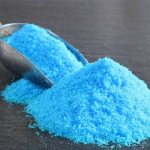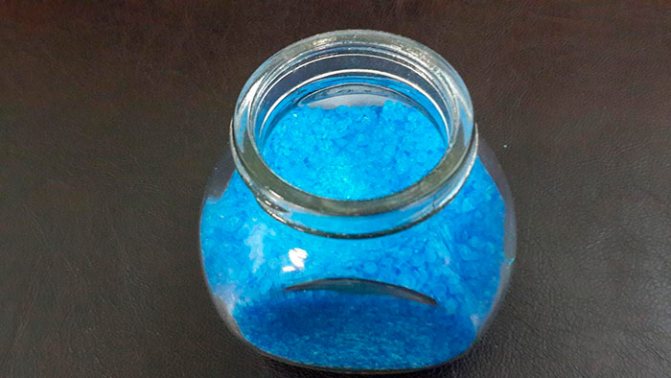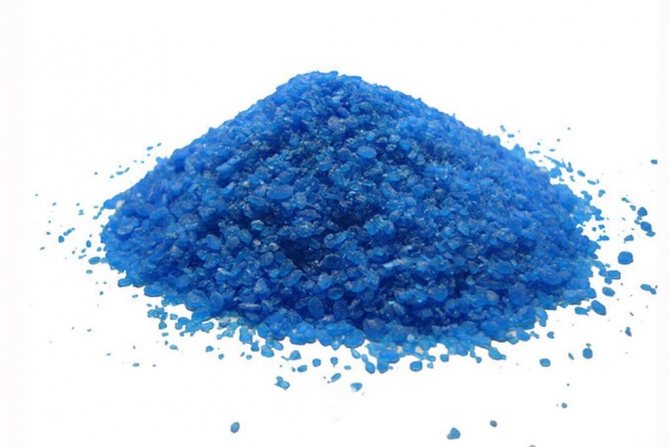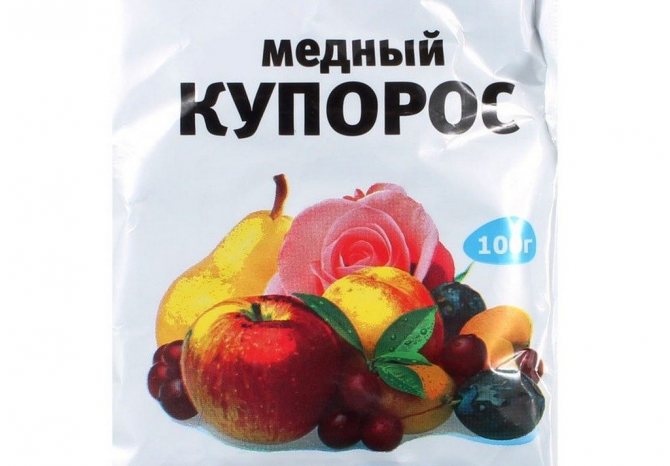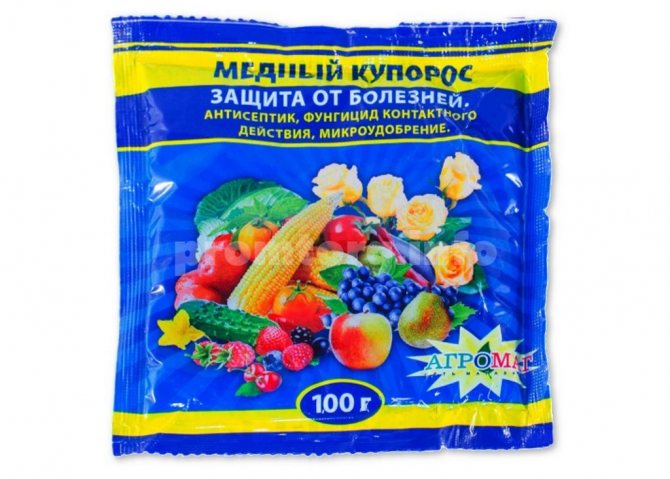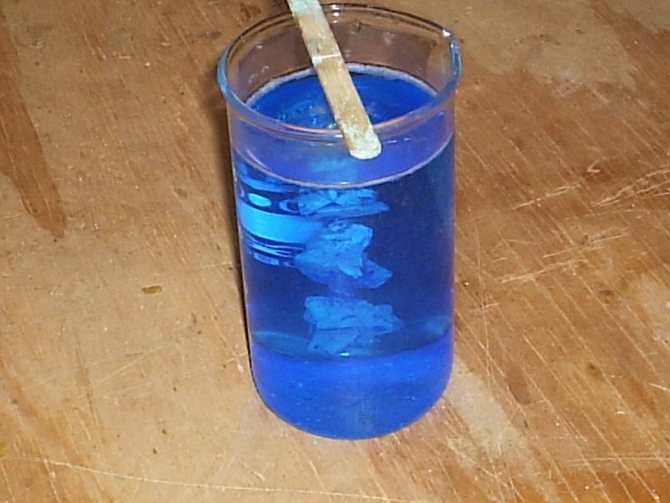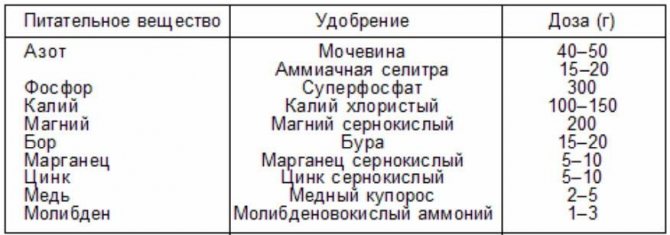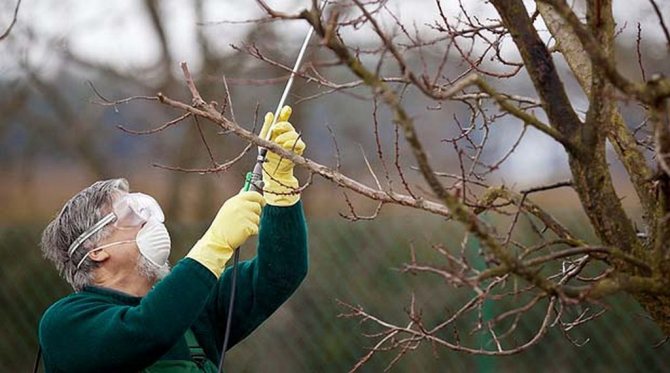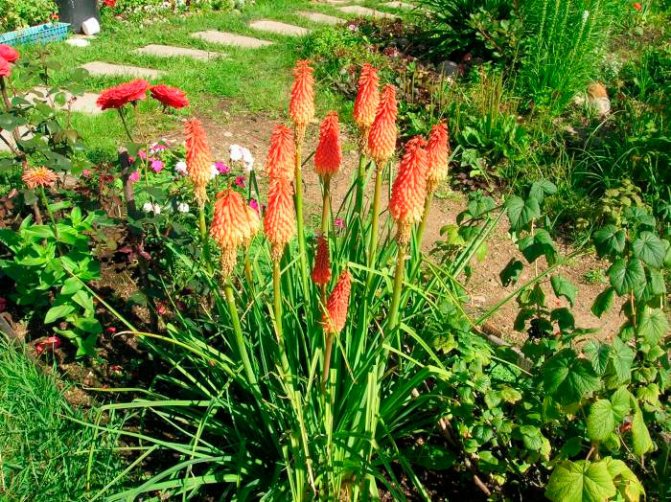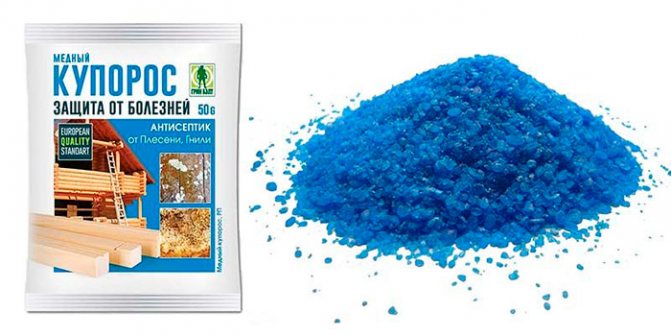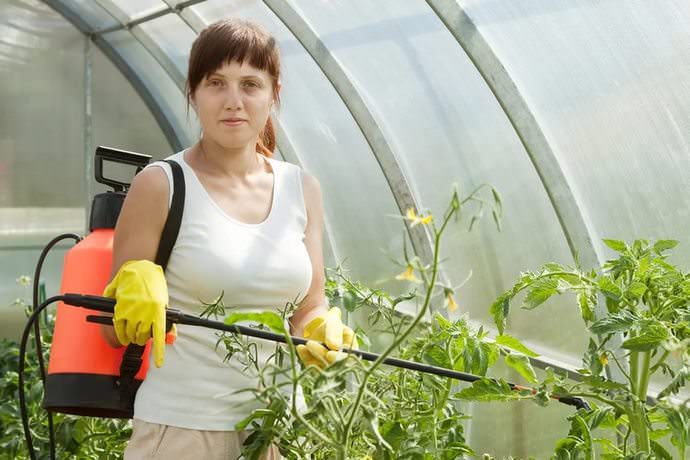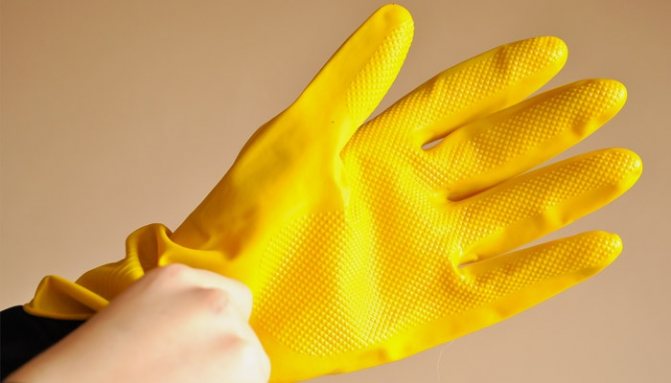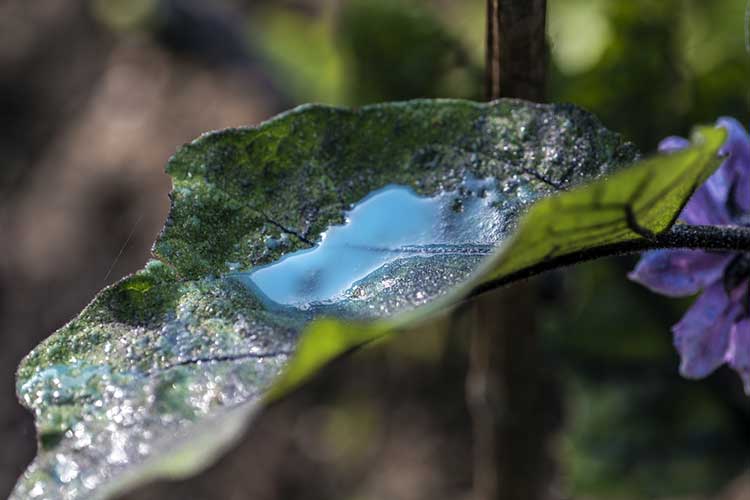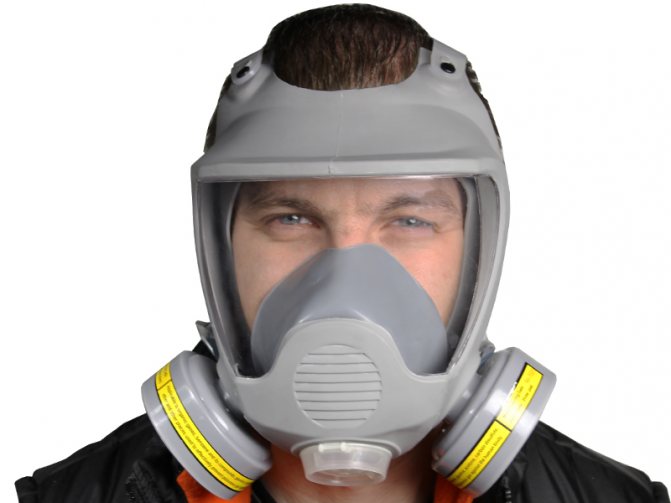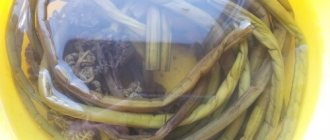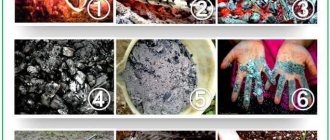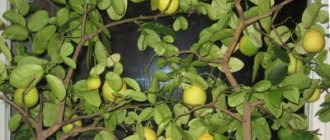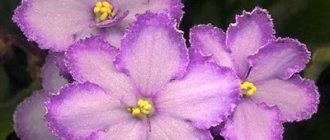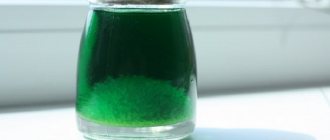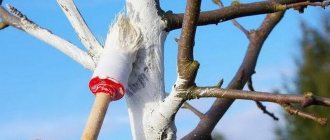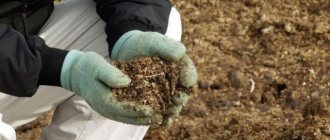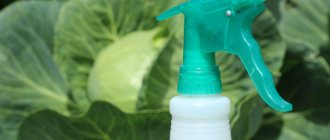Among the chemicals used in every household, copper sulfate, which is a crystalline hydrate of copper sulfate or copper sulfate, is far from the last place. This substance is poisonous to humans, but it is widely used in various fields of industry and agriculture.
Copper sulfate powder for the preparation of copper sulfate
Scope of copper sulfate
Copper sulfate has a fairly wide range of uses. Basic:
Agriculture:
- used as a bivalent fungicide for pest and fungus control;
- it is used as a top dressing and fertilizer for plants;
- with a deficiency of copper in the soil, it is used as a top dressing;
- is an algicide for pond irrigation.
As a water purifier:
- used for water purification in swimming pools, ponds, reservoirs;
- for chemical treatment of water
For livestock:
- food additive in the feeding of farm animals;
- to stimulate the growth of chickens and pigs;
- disinfection and prevention of bacteria in livestock;
- antiseptic and bactericidal in fungal infections.
In the mining industry:
- obtaining flotation of lead, zinc and cobalt
In metallurgy:
- solution for electroplating baths;
- production of copper printed circuit boards, electric batteries;
- obtaining copper cathodes.
Other industries:
- catalyst for copper trace elements in production;
- as antimicrobial agents in pharmaceuticals;
- in the production of dyes and pigments, in the leather, ceramic, textile industries;
- in the production of mirrors and glass;
- in the oil industry.
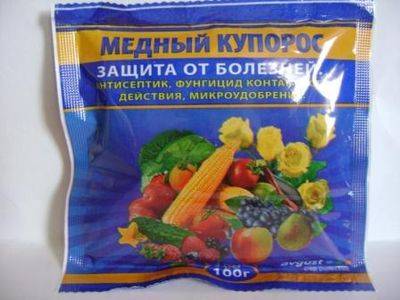
We recommend reading: Diuretics for leg swelling - what will help?
First aid for possible poisoning
Copper sulfate does not pose a serious threat to human life and health, since it will take too much of the substance to be fatal.
However, with careless use, poisoning is possible, the main symptoms of which are:
- Pain in the stomach.
- Vomiting, feeling of nausea.
- Increased heartbeat.
- General weakness in the body.
- Itching, the presence of redness and various skin rashes, other manifestations of an allergic reaction.
- The main symptomatology of toxic shock.
If any signs of copper sulfate poisoning were recorded, then urgent assistance to the victim is required, it usually consists of the following:
- Initially, the affected person must be provided with access to fresh air., give water to rinse the mouth and change the clothes that were on him while working with the drug.
- If the solution comes into contact with the skin, the contaminated part of the body must be washed with water, brought to room temperature, the use of soap is recommended, but washcloths and other similar devices are contraindicated.
- In case of contact with eyes or other mucous membranes, it is required rinse them with plenty of clean cool water.
- If inhaled, let the person breathe. fresh air.
- If you have an allergic reaction or skin rashes, use drugsthat eliminate these symptoms, for example, Tavegil or Suprastin.
- If it enters the digestive system, it is required to drink at least half a liter of cool water, in some cases it can be replaced by several egg yolks. It is also necessary to take activated carbon, but it is not allowed to artificially induce vomiting to remove the substance from the body.
- Unithiol is most commonly used as an antidote., which is injected intramuscularly in accordance with the instructions for use of this drug.
After that, in any case, a mandatory appeal to a specialist will be required, who will explain the further procedure for eliminating the toxic effect.
Copper sulfate in horticulture
Copper sulfate has long established itself as an excellent tool in the fight against pests, pathogens of plants and trees, the destruction of mold and mildew, for disinfection. In addition, an equally important fact in its favor is that it does not form any toxic compounds, and its presence in the soil is safe for humans. Copper sulfate itself is not flammable and does not cause fires, but when heated, it can pollute the air with toxins that can cause poisoning in humans. Therefore, the ideal time for its application is calm, not hot weather, the air temperature should be within 15 degrees. It is also not recommended to use it in rainy weather, otherwise there will be no effect from using it.
It is currently used in horticulture for:
- preparation of Burgundy and Bordeaux liquid;
- for spraying plants with fungi and pests;
- spraying fruit trees;
- preparation and nutrition of the soil in which there is a deficiency of copper.
Preparation of Bordeaux and Burgundy liquids
Bordeaux and Burgundy mixtures are good fungicides for treating plants and trees against pests, fungi and harmful bacteria.
Despite the fact that both of these liquids are sold ready-made in stores, many summer residents do not trust them and prefer to make them on their own.
To prepare Bordeaux mixture you will need:
- powder or crystals of copper sulfate;
- lime.
For early spraying, a 3% mixture is usually prepared, and for a more gentle (during the growth period) 1%. To prepare a 3% mixture, you will need 300 g of vitriol and 400 g of lime diluted in 10,000 milliliters of water, to prepare 1% of the mixture, you need to take 100 g of vitriol and 100 g. Lime per 10 liters of water.
Vitriol and lime must first be diluted in separate containers. To do this, you can take plastic, plastic or glass containers. Never use metal!
First, stirring, dilute vitriol in 1 liter of warm, but not hot water, no more than 50C. After the crystals are completely dissolved, bring the volume up to 9 liters with water.
In a separate container, dissolve lime in 1 liter of water.
Then let the vitriol solution cool and gently pour it into the lime solution, stirring occasionally. This must be done in this sequence, and not vice versa. Otherwise, the solution will be useless.
Once the mixture has been prepared, it should be used as soon as possible. This mixture helps to cope well with such pests as late blight, curliness, rust, scab, coccomycosis, etc. It is very effective in combating grape diseases.
To make a burgundy mixture you will need:
- copper sulfate;
- soda ash (linen soda);
- laundry soap.
To prepare 10 liters of solution, it is necessary to dilute 100 g of copper sulfate in 5 liters. hot water and in a separate container 90 g of soda and 40 g of soap to dissolve in 5 liters. warm water. Then carefully pour the solution with vitriol into the solution with soda. You will get a green solution, which must additionally be filtered, and it is ready to use.
Burgundy mix does not stick to the leaves as hard as Bordeaux mix.And this is a plus when spraying vegetable crops, since it manages to kill the spores of painful fungi, but does not stay on the leaves for long. Also, according to many reviews, it protects currants, grapes and gooseberries much better. The advantage is also that it contains calcium, thereby nourishing the plant and soil with it.
Spraying plants and trees with copper sulfate
As a rule, many people prefer to use for these purposes a more gentle Bordeaux or Burgundy mixture, which does not leave burns on plants, however, there are still people who want to use copper sulfate without additives.
For spraying with copper sulfate, a 1% solution is prepared. For this it is necessary to dissolve 0.1 kg. crystals in hot water, then bring the volume to 10 liters with cold water.
The first treatment in this way takes place in early spring before bud formation. In this case, it is important that the air temperature does not fall below 5C. This treatment allows you to get rid of the larvae in the bark of trees that safely lived in it, fleeing winter.
To protect tomatoes from late blight, prepare a 0.5% solution (50 g per 10 liters of water). Then the solution is poured into the root, about 5 liters. under one plant.
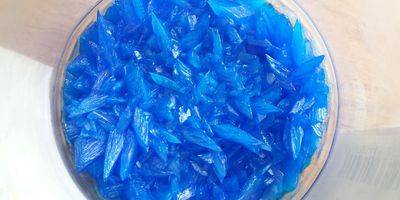

We recommend reading: Feet stink, what to do and how to help yourself?
Tillage
Tillage can be carried out in early spring or late autumn. This procedure will help get rid of painful spores that lead plants to diseases such as late blight, powdery mildew, root eater, macrosporiosis, peronosporosis, white and root rot, septoria, moniliosis, anthracnose and others.
Before starting treatment, it is necessary to prepare the soil, it is recommended to dig it up and remove it from plants, leaves and dirt.
Then prepare the required solution of 10 liters. Given that vitriol increases the acidity of the soil, it is better to breed it with lime. To do this, in one container we dilute 3-5 g of the substance of copper sulfate in a small amount of warm water until completely dissolved, then add water to 5 liters. In a separate container, we dilute slaked lime in 5 liters. water, after which it must be filtered. Then carefully pour the solution of copper sulfate into limestone, not forgetting to stir.
For soil cultivation, 10,000 ml are used. solution for 1 sq. meter.
When using copper sulfate on the site, the following safety measures must be observed:
- Processing should take place on the territory cleared of old leaves and grass.
- During processing, there should be no children or animals nearby.
- It is necessary to carry out the treatment either in the early morning or in the evening in calm and not rainy weather, at an air temperature above 5C and not exceeding 25C.
- It is imperative to use protective clothing, skin and mucous membranes must be covered.
- After finishing the treatment, wash your hands thoroughly with antibacterial soap and rinse your mouth.
- Do not pour leftovers into a river, lake or any other nearby body of water.
- Not recommended for use during flowering.
Bordeaux liquid
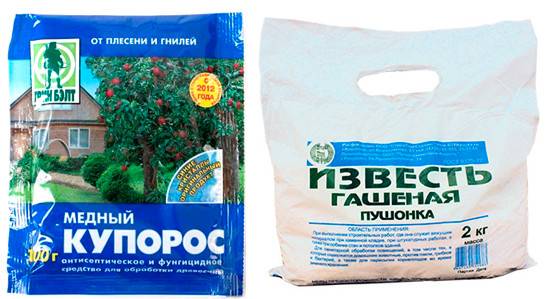

The popularity of Bordeaux liquid in horticulture is due to many reasons.
Solutions of copper sulfate fight well against diseases and pests, but they oxidize the soil and, if used incorrectly, cause light burns to plants. To mitigate negative factors, Bordeaux liquid was invented - the same solution of copper sulfate with all its positive properties, but softened in action with lime.
For the first time such a mixture was prepared by the French living in the province of Bordeaux, hence the name. Bordeaux mixture is easy to prepare. You need to take 100 grams of quicklime and 100 grams of dry powder of copper sulfate.
Important!
- Do not mix powders directly! Namely: first we dilute lime.As vitriol, we dilute it in half a liter of water, extinguish 100 grams of lime in 0.5 liter of water. And then we bring the volume of water to 5 liters. The result is a characteristic "milk of lime". In another container (not metal), we also gradually dilute the copper sulfate and add up to 5 liters.
- Only now, stirring continuously, pour the solution of copper sulfate into the "milk of lime". Not the other way around (lime to vitriol)!
- The resulting Bordeaux liquid is stored for no more than five hours! Longer holding times will cause lime particles to stick and clog the sprayer.
For the convenience of gardeners, there are ready-made sets of Bordeaux powder mixture on sale, which include a bag of 100 gr. copper sulfate and 100 gr. slaked lime. Thus, the use of copper sulfate is simplified as much as possible and will help in the improvement of garden plots. It is an excellent fungicide with proven effectiveness. The main thing is to follow all the recommendations!
The use of copper sulfate in animal husbandry
Copper sulfate is used in animal husbandry to combat:
- with fascioliasis disease or hepatic bugs. Cattle, horses, pigs, sheep and goats are susceptible to this disease;
- in the treatment of ringworm. To treat sick animals with it, a 20% solution of copper sulfate in ammonia is used;
- against the disease of animals with thrush;
- to combat hoof rot, common in sheep. For treatment, a 10-15% solution of vitriol is used every 3-4 days;
- add to animal feed to combat anemia;
- used in feed for piglets for rapid growth.
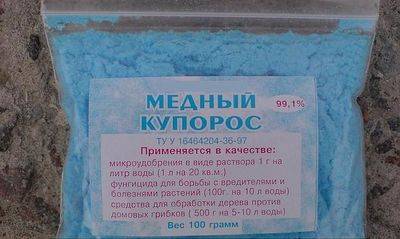

We recommend reading: Why do pregnant women get numb hands?
Rules for the preparation of the solution and spraying
- It is necessary to prepare the mixture in a glass container that is not used for cooking. Do not use metal containers so that vitriol does not corrode the metal.
- Do not dissolve the contents of the sachet or bottle in the kitchen.
- The water for the solution must be hot, not less than +50 degrees. It is impossible to use warm water, as well as cold water, since the "cocktail" will turn out to be cloudy and ineffective.
- The solution should be prepared in a water bath, which will allow the mixture to be stored for a year, dissolving in the right amount of water.
A solution of copper sulfate has a high level of absorption into the skin through sweat, so it is worthwhile to carefully work with the prepared mixture. Basic Precautions:
- Pets, children, foreign objects and plants must not be near.
- The chemical should not be allowed to enter drainage, water supply and sewerage systems.
- It is necessary to prepare the mixture with gloves and a respirator. If possible, do not wear rubber gloves. The whole body should be covered with clothing.
- The room in which the solution is prepared must be ventilated. You can open windows and doors, turn on the hood, etc.
- After the completion of the work, the room must be constantly ventilated for several days.
If vitriol gets on the skin or eyes, then you must quickly wash off the substance with clean water. The eyes do not close at the same time. When the mixture has entered the body, it is urgent to drink a few raw eggs or 0.5 liters of milk. If you feel worse, you need to call an ambulance without self-medication.
Copper sulfate in medicine
Copper sulfate has long established itself in unconventional methods of treatment - in folk medicine. In ancient India, it was used to treat diseases related to the eyes and skin. In Greece, the substance was actively used in the treatment of tonsils, tonsillitis and deafness.
In modern medicine, it is used to treat epilepsy, bruises, joint problems, sciatica, tumors, female diseases and many others.
Baths with the addition of copper sulfate have also worked well as a remedy for diabetes. It has been proven that after taking such baths, the need for insulin decreases by 4-5 times, and in case of mild diabetes - for good.It is recommended to carry out a procedure of 15 baths, 2-3 times a week. To do this, add 2-3 tbsp to the bath. tablespoons of copper sulfate and lie in it for 10-15 minutes.
An ointment made from copper sulfate can get rid of nail fungus. To do this, it is necessary to mix in equal proportions goose fat, copper sulfate and white sulfur powder. All this is mixed, brought to a boil and cooled.
Also, among women, it is common to douch with copper sulfate to combat such female diseases as fibroids, cervical erosion, cysts, and inflammation of the appendages. To prepare the solution, you will need a tablespoon of vitriol, a liter of water and a spoonful of burnt alum. Mix all this and boil for 5 minutes, then strain and cool. The resulting blue water can be used for douching.
Using vitriol mixed with olive oil, you can prepare an ointment with a warming effect for the treatment of bruises and arthritis, as a wound healing agent. To prepare this ointment, you will need: 15 g of copper sulfate, 50 g of olive oil, one grated onion, 20 g of spruce needles. All ingredients must be mixed well and boiled.
A good effect is produced by tincture of vitriol in the treatment of breast, stomach and intestinal cancer. To prepare it, it is necessary to dilute a pinch of the substance in half a liter of boiled water and let it brew for 24 hours. It must be taken in the morning on an empty stomach, 50 ml.
Products prepared with copper sulfate have a calming effect on the body, helps to cope with insomnia, strengthens the immune system, and protects against infections.
Nevertheless, it is recommended to consult a doctor before using it.
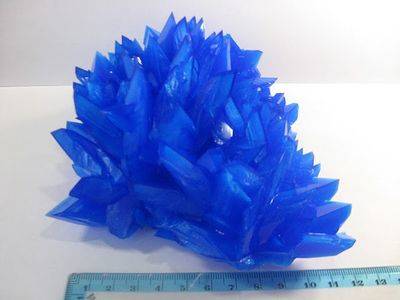

Nail fungus treatment
There are a large number of different fungal diseases, the most common are those that affect the nails. Almost any person can face a similar ailment, and many prefer to treat the disease at home, rather than seek help from specialists.
However, before starting treatment, it will also be necessary to pay due attention to the process of preparing the salvage solution:
- Prepare a plastic container, which must be filled with boiled water at room temperature.
- Add copper sulfate powder to the water, while it is important to observe the proportions, for a liter of water you will need to use no more than one teaspoon of the product.
- The resulting solution can be poured into containers of any volume and then stored in dark and cool places, referring to it as needed.
After the solution has been properly prepared, you can proceed directly to the treatment process, for this you must observe the following sequence of actions:
- Prepare a basin or a special tray, which must be filled with water. It should be moderately hot, that is, heated to such an extent that a person can safely tolerate contact with it.
- Add a solution of copper sulfate to the heated water, the most important thing in this process is compliance with dosages. One and a half liters of hot water requires about one teaspoon of the solution.
- The duration of one procedure is 20-40 minutes.
- After the specified period, the treated and steamed areas of the body will need to be thoroughly dried with a dry towel.
- Apply a special healing cream to them or treat them with lotion, these drugs are prescribed by a specialist.
Read also Pus in the ears of rabbits
When treating nail fungus with copper sulfate, it is important to remember the following features of this process:
- Achieve a positive result is possible only at the initial stage of the disease. If the situation was started, then more serious measures will be required for treatment.
- In any case, a consultation with a doctor will be required, since only he is able to make an accurate diagnosis, and it is best to completely get rid of the disease by using complex measures.
- Observe precautions when using copper sulfate and do not exceed the permissible doses of this agent.
Precautions
When working with copper sulphate, you must observe the following precautions:
- When working with this substance, be sure to wear protective boots, gloves, glasses. If it comes into contact with the skin, it should be washed immediately. If the protective clothing is dirty, it must be changed, it is not allowed to continue to work in it.
- Copper sulfate is an irritant. If inhaled, you can get toxic poisoning. May cause itching and eczema on contact with skin. When in contact with the eyes, copper sulfate can cause conjunctivitis, inflammation of the eyelids, and corneal opacity.
- It cannot be stored in metal containers. Copper sulfate is highly corrosive to steel, iron and galvanized pipes. When transporting it, it must be classified as a hazardous substance or hazardous waste.
- Its combustion provokes the formation of poisonous gases and extinguishing it with water can cause environmental pollution.
- Signs of copper sulfate poisoning are a metallic taste in the mouth, burning in the chest and abdomen, severe nausea, vomiting, diarrhea, headache, sweating. Also, when poisoning with copper sulfate, damage to the brain and the work of internal organs - liver, kidneys, stomach and intestines.
- Copper sulfate is highly toxic to fish and aquatic invertebrates such as crabs, shrimps and oysters.
- Toxic to sheep and chickens in normal doses.
- After the widespread use of copper-containing fungicides in gardens, the death of most of the animals in the soil, including earthworms, was observed.
- According to the studies conducted, the minimum dose of copper sulfate, which has a toxic effect on humans, is 11 mg / kg.
the main
> Preparations> Copper sulfate and its use in various fields
Rate the article:
Conditions of use and safety
When working with copper sulfate, it is worth following all personal safety measures. As already mentioned, the solution is prepared with gloves. In case of contact with the skin, there will be no special changes, but it is worth rinsing with water.
When spraying plants, you need to wear a protective mask and, preferably, a cape. Processing is carried out in calm weather in the morning or evening hours, it can be sprayed during the day, but only when it is cloudy. You also need to find out the weather forecast for the days coming after spraying, so if rain is expected, then it is better to postpone the treatment. The rain will wash away the drug and reduce its effect to zero, and along with your efforts.
Follow all instructions and recommendations, and your plants at their summer cottage will thank you with generous harvests.
What is copper sulfate?
Copper sulfate is a very popular fertilizer today, since it has been tested for years in the practice of gardeners and the results of its use are only positive. It consists of a blue-colored chemical that looks like a powder.
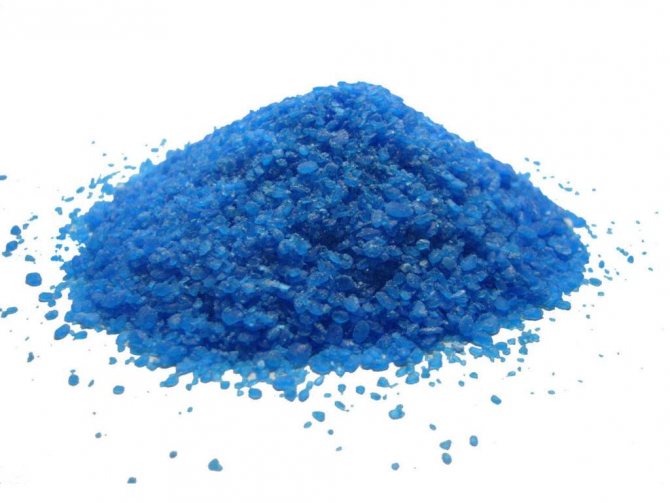

It got its name because of the copper sulphate in its composition of more than 20%. Other names for this substance in the chemical classifier are copper sulfate or sulfuric acid. The hygroscopicity of the powder is very high; it dissolves in liquid perfectly without sediment. It is also important that the substance does not belong to the fire hazard group.
How is copper sulfate obtained?
- Refining copper by electrolytes.
- Dissolution of copper in sulfuric acid.
- Roasting of copper sulfites.
The area of application of copper sulfate is extensive.It is indispensable in the metallurgical industry, in the nickel plating process, as a raw material in various chemical processes, as a reagent for the determination of metals in an alloy, serves as an excellent antiseptic, in the woodworking industry, in medicine, agriculture, horticulture and even the food industry (it is a preservative E519).
Chemically, copper sulfate is formed by the reaction of copper with sulfuric acid, resulting in the salt that received this name.
For humans, it is harmless, despite the fact that it belongs to a number of toxic substances. A safe dose is up to 1 g, and it is impossible to accidentally take it inside. The same cannot be said about waterfowl. Therefore, it is necessary to carefully apply a solution of copper sulfate near water bodies. It is necessary to strictly follow the instructions for use, and also it is necessary to adhere to personal protective equipment when working with this substance.
Copper sulfate as fertilizer - what is it and how it works
Copper sulfate is an inorganic compound used to kill garden pests and fungal diseases. From a chemical point of view, copper sulfate is a copper sulfate salt. In stores, the product is sold in the form of deep blue water-soluble crystals. The solution has the properties of fungicide, insecticide, antiseptic and fertilizer.
The effectiveness of copper sulfate is explained by the presence of copper in its composition, which is a prerequisite for redox and metabolic processes. With an insufficient amount of copper, the plant weakens, and its resistance to infections decreases. If you restore the missing amount of copper, the agricultural crop not only becomes more hardy, but also the taste and quality of the crop improves:
- sugar levels rise in root crops;
- in cereals, the fat content increases;
- in fruits and berries, the amount of sugars and acids increases;
- in potato tubers, the percentage of starch content increases.
Application in horticulture
Grapes sprinkled with copper sulfate
The main function in horticulture is toProtection of vegetable and fruit crops from diseases and pests... It is also useful for ornamental plants. Almost everything in the garden is treated with it - trees, shrubs, vegetables, fruits, flowers. He fights against fungal diseases and many pests, including scab, all types of spotting and rot.
He performs and excellent antiseptic in the garden, if you need to disinfect something, it's better not to find it. It is also widely used as a microfertilizer to enrich the soil with copper. Since the substance belongs to fungicides, when processing plants, it acts only on the surface, without penetrating inside, which makes it safe for the garden. When washed off with water, the effect on the plant completely ceases. It is used in the garden for three seasons.
Spring
Spraying is carried out in calm weather.
After the end of winter frosts, copper sulfate is indispensable in the garden. In the spring, it is necessary to spray the trunks and crowns of all trees and shrubs in the garden with this solution to destroy all fungal infections that have successfully overwintered and will begin their vigorous activity in the spring.
The following proven dosages of the solution are recommended:
- Pome crops - 1% solution.
- Stone crops - 0.5% solution.
- Shrubs - 1.5% solution.
Processing is carried out until the buds swell on trees and shrubs. It is necessary to carry out the procedure only in good weather, when there is no wind and precipitation.
Summer
After the spring processing has passed in the garden, processing begins in the summer.
- They process the roots of seedlings to treat them against fungal diseases... To do this, the roots of the seedlings are dipped in a 1% solution for no more than 3 minutes, after which it is imperative to rinse them well with water.
- Sulfuric acid acts the main component in the manufacture of Bordeaux mixture for the garden and vegetable garden, which is simply irreplaceable for any gardener. Almost all plants in the garden are treated with this mixture to protect against pests and diseases. This mixture can be used as a prophylaxis once every 2 months.
Autumn
The autumn treatment of the garden with sulfate in the fall is very important, since the garden must be protected in the winter, in which pathogens are actively appearing.
Instructions for use
Copper sulfate is used in the garden for processing shrubs and trees, fertilizing the soil, and fighting fungal diseases and pests. Any work using copper sulfate is best done in the first half of spring.
The concentration of the solution is calculated individually for each volume of work and type of plant. When working with copper sulfate, first of all, it is important to observe the dosage and technology, in this case the fertilizer is not toxic and not dangerous for humans and insects.
It is advisable to carry out the first processing of trees in March, when the average temperature does not drop below +5 degrees. Before processing, you need to prepare the plants:
- cut off old, lifeless branches and shoots affected by the disease;
- the trunk and branches are cleared of lichens, dead bark is removed;
- places of cuts and cracks are treated with garden pitch;
- fallen leaves are removed around the plants.
All harvesting activities must be carried out before the buds swell in order to avoid infection of trees by insect larvae that hibernate in old, rotted leaves and the upper layer of the earth.
Immediately before working with copper sulfate, you must:
- check the expiration date on the package;
- prepare gloves, respirator and goggles;
- while working with a chemical, do not drink water or eat;
- while processing plants, remove children and animals from the site;
- spraying is best done in cloudy and calm weather or in the early morning and late evening;
- the optimum air temperature is not lower than +5 degrees and not higher than +30 degrees;
- if a solution remains after work, it must not be poured into the reservoir.
At the end of all work in the garden, you should thoroughly wash your hands with soap and rinse your mouth with warm water.
Dosage
Copper sulfate powder
In horticulture, it can be used in different dosages depending on what needs to be processed and when.
Compositions based on copper sulfate are very actively used. Among them, the most popular are:
- Burgundy liquid... To do this, add 200 g of sulfate and 200 g of soda to 20 liters of water.
- For processing plants the substance is diluted in a proportion of 5 grams of vitriol per 10 liters of water.
- For spraying trees and shrubs 100 g of the drug is added to 10 liters of water.
- In order to disinfect the ground, add 7 g of a chemical to 10 liters of water and water the land.
- For getting rid of powdery mildew, which manifests itself in the form of whitish spots on plants, a vitriol-soap solution is used, which is prepared from 20 grams of a chemical with 150 grams of household 72% soap and diluted in 10 liters of water.
How to prepare different solutions?
When used for various purposes, solutions with different percentages of water and powder have to be used. Therefore, it will be useful to know how to get copper sulfate for processing different concentrations:
- 0.5-1% - a solution for the treatment and prevention of various plant diseases and their protection from insect pests, for lubricating wounds on branches and trunks. Take 50 g of crystals for 10 liters of water or 100 g for the same amount of liquid.
- 0.2-0.3% - solution for plant nutrition and prophylaxis. It is prepared from 20 grams of substance per 10 liters of water and, accordingly, 30 grams per 10 liters.
- 3-5% - the most concentrated solution, prepared from 300 or 500 grams of dry matter per 10 liters of liquid. It is used quite rarely, it is suitable for fighting mold on the walls of premises.
Soil enrichment with copper
Copper is essential for normal plant life. In the absence of copper in the ground, the plant begins to ache and grow poorly. This has a negative impact not only on agriculture, but also in animal husbandry. Since the animal does not receive the required amount of iron from the plant that it eats, as a result, the meat will not be saturated with vitamins and iron. Therefore, the soil is enriched with copper using copper sulfate. The deficit is established by soil and animal meat analyzes.
Enrichment takes place as follows:
- In the spring, before planting, 50 kg of the chemical is applied per hectare of land.
- Spray on all plants a composition of 1 kg of sulfate up to 4000 water (the exact dosage will be determined by soil diagnostics).
- For peat soils, which are poor in copper, in the fall it is necessary to add per 1 sq. m 1 g of copper sulfate.
- For acidic soils, they are applied per 1 sq. m 1 g of copper sulfate and 450 g of slaked lime. The procedure is carried out in the fall.
Basic Precautions
This tool belongs to the third class of hazard, in other words, it is moderately dangerous and toxic for humans and warm-blooded animals.
To avoid them, the following are basic precautions:
- During any handling of the granular powder or a ready-made solution is strictly forbidden to smoke, consume food or drinks, as this can lead to accidental ingestion of the substance into the digestive system.
- When working with the drug, it is necessary, if possible, to keep all parts of the body closed., additionally wear safety goggles, a hat and disposable rubber gloves, as well as a respiratory mask to protect the respiratory system.
- No pets or small children should be in the room during processing. It is recommended, if possible, to leave the room for all persons not related to this process.
- The dishes used for working with copper sulfate must be disposed of in the future., it is not allowed to use it for any household purposes.
- After completing work with the drug, you must thoroughly wash your hands and face with soap., rinse the mouth and wash the clothes that were worn at the time of using copper sulfate.
- It is strictly forbidden to allow any amount of substance to enter water bodies or any source of water supply.
- When processing plants and various crops, you must wait until the end of the flowering process.
- It is forbidden to use the drugif the ambient temperature is equal to or higher than + 30 ° C.
- It is forbidden to use the toolif it has already expired.
- If the product in the form of a powder was accidentally scattered, then it can be collected and further used for its intended purpose. If a solution has been spilled, then sawdust or sand will help to absorb it, after which they should be buried in the ground, but this must be done at a sufficient distance from residential areas and reservoirs. In the same way, the disposal of empty containers from copper sulfate occurs.
- During any work with copper sulfate, it is necessary to provide fresh air access to the room. After completing all procedures, it will need to be ventilated for 15-20 minutes.
Recommendations
When working, use personal protective equipment, rubber gloves, a respirator and special clothing
In the process of work, it is necessary to adhere to the following rules in order to use it efficiently and safely:
- Buy only in special stores that have a quality certificate for this chemical product.
- Read the instructions for use very carefully.
- When working, use personal protective equipment, rubber gloves, a respirator and special clothing.
- After handling, wash hands and face thoroughly with soapy water. Rinse your mouth well with warm water.
- Dilute the solution in a special non-metallic container. At the end of the work, thoroughly wash all equipment.
- First, dissolve the powder in a liter of warm water, and then add the rest of the liters.
- Only freshly prepared solution is used.
- Pour the remaining solution away from water bodies and animals.
If you use the drug wisely, follow all the requirements and recommendations that are indicated in the instructions, then the result of using copper sulfate in the garden will only be positive, since it has been tested for decades and its effect has been proven and tested scientifically.
Safety regulations
!!!!!!!
- It is best to dissolve copper sulfate in a glass, enamel or plastic container. Metal (iron or galvanized) containers cannot be taken - oxidation will occur.
- Do not prepare a solution of vitriol in the kitchen or near food. The best thing is to go out into the garden and plant there.
- When preparing the solution, it is worth wearing gloves and a protective mask, and when spraying trees, put on a plastic raincoat.
- When spraying, there should be no pets, children or people nearby.
- Avoid getting the solution in the eyes. And in case of contact, immediately rinse them with clean water.
- It is unacceptable to take the solution inside. But if this happens, it is recommended to drink 2-3 raw eggs or 300-500 ml of milk and call an ambulance. Drinking a lot of potassium permanganate or plain water is useless.
!!!!!!!
The use of copper sulfate for processing plants
In cases of using copper sulfate to protect plants from pests and diseases, it is imperative to take into account that all preparations based on copper have only a preventive protective nature, since copper is adsorbed by fungal spores and affects only them, and not the mycelium itself, already penetrated into the cells. Therefore, treatment with copper-containing fungicides to combat pathogenic diseases is most effective at a time when the plants are still not sick - from the beginning of the formation of spores on diseased specimens until they spread to healthy ones. Since the greatest need of plants for copper is noticed at the beginning of the growing season and significantly weakens by the beginning of flowering, and the solution of copper sulfate has an acidic reaction, which expresses a burning effect on the leaf apparatus, it is best to use this fungicide for preventive spraying in early spring (for unopened buds) or late autumn (after the end of leaf fall). A solution at a concentration of 100 g of copper sulfate per 10 liters of water is rational to use to combat moniliosis, drying out, scab, phyllostictosis, anthracnose, coccomycosis and other spots, curliness, clasterosporium and moniliosis on pome fruits (pear, quince, apple trees), and on shrubs gooseberries, currants, raspberries) as well as stone fruits (peach, apricot, plum, cherry, sweet cherry) crops ,. The consumption of the finished solution must be no more than 2 liters for one young (not older than 6 years), about 10 liters for one fruit-bearing tree, and not more than 1.5 liters for a bush. Please note: it is strongly advised to prepare a solution of copper sulfate right before spraying, dilute the powder in a small amount of water, and then bring its volume to the desired concentration, and carry out the spraying procedure itself once, and it is better early in the morning or late at night in dry, calm weather, and preferably at least 4 hours before expected precipitation (rain).
Copper sulfate solution can also be used for other purposes:
- For treating wounds of fruit shrubs and trees (solution at a concentration of 100 g per 10 liters).
- For treating roses to combat black leaf spot and powdery mildew.The solution is prepared at a concentration of 50 g per 10 l, and spraying is carried out in late autumn.
- For disinfection of the roots of rose seedlings, berry and fruit crops after removing the growths of root bacterial cancer from them. The root system is immersed in a 1% solution (100 g per 10 l) for a couple of minutes, and then washed well under running water. In a similar way, it is also possible to process strawberry whiskers and currant and gooseberry shoots when the first signs of powdery mildew are found on them.
- To prepare for sowing vegetable seeds. To disinfect pumpkin seeds, squash, tomatoes and zucchini from "hereditary" diseases, it is advised to keep them in a disinfectant solution for 15 minutes (dissolve 2 g of boric acid, 10 g of potassium permanganate and 1 g of copper sulfate in 10 liters of water), and then rinse the tomato seeds thoroughly clean water. To obtain early shoots, seeds of celery, cucumbers, beets, onions, carrots and tomatoes must be soaked in a solution of copper sulfate (2 - 3 g per 10 l of water). The solution should be prepared with warm water (40 - 45 ° C) and the seeds of cucumbers should be kept in it for no more than 12 hours, and for other garden crops - no less than 24. In the fight against late blight of potatoes, pre-plant spraying of tubers (2 g of copper sulfate per 10 liters of water).
- For the treatment of actively growing plants in order to protect against pests and fungal diseases. To do this, it is necessary to use either a not very concentrated solution (no more than 20 g per 10 l), or a combination of copper sulfate with other components that would slightly soften its phytotoxicity. For example: with downy mildew of cabbage, leaf mold and brown spot of tomatoes, dilute 1 tablespoon in 10 liters of water. laundry soap and copper sulfate powder. And to combat gray mold of cucumber, you can use a dry mixture of ash (1 tbsp) and copper sulfate (1 tsp), which must be sprinkled on sore spots.
Pay attention: the duration of the action of the copper sulfate solution is on average 7 - 12 days, but in dry weather (in dry soil), the absorption of copper may be delayed, and with prolonged wet weather, the effectiveness of the fungicide may either subside or its phytotoxicity may appear. In this regard, gardeners, gardeners and winegrowers often give preference to mixtures with copper sulfate - Bordeaux and Burgundy liquids and their analogues available for sale.
How and when to process plants?
Copper sulfate is used in horticulture and when growing vegetables in certain concentrations and at a certain time. We must try to comply with these deadlines.
Spring processing pursues preventive goals:
- In early spring, when there is no longer a risk of repeated frosts, and the air warms up to +5 degrees, watering is carried out to prevent diseases with rot, black leg, yellowing of leaves (in tomatoes, cabbage, root crops). Apply a 0.5% solution at the rate of 3-4 liters per square meter.
- Before budding on trees and bushes, a 1% solution is used to prevent diseases.
- Disinfection of the roots of seedlings. Soak in 1% solution for 3 minutes, then rinse thoroughly.
- Copper sulfate is used to protect potatoes from late blight in the proportion of a 0.2 percent solution. They are treated with tubers before planting in the ground.
In summer, copper sulfate is also used for processing plants. Application in gardening, as well as for vegetable growing, is necessary during this period when the initial signs of the disease are detected:
- For apple, pear and quince trees, they are used against scab, drying out, various types of spotting, moniliosis. The solution is prepared from 100 grams of copper sulfate per 10 liters of water.
- To preserve apricots, peaches, sweet cherries, cherries, plums, they fight against coccomycosis, curliness, and moniliosis. A solution of 50-100 grams of substance per 10 liters of water.
- Gooseberry bushes, currants protect against anthracnose, all types of spotting. The solution is the same as in item 2.
- For tomatoes and potatoes, it is used with a lack of copper and with signs of late blight. Take a 0.2% solution. Can be re-processed after 3-4 weeks.
- A 1% solution of copper sulfate is used to treat wounds on fruit trees. On berry bushes, the solution is taken in 2 times lower concentration.
- Using crystal powder when added to lime tree whitewash will help keep pests out of your garden.
Description and chemical composition of copper sulfate
Divalent copper sulfate (equation CuSO4) are small blue or blue crystals. The odorless, non-volatile product has an astringent, bitter taste with hints of metal. In the natural environment, the chemical is found in minerals. In industry, the material can be obtained by the action of sulfuric acid on the main component.
Copper sulfate dissolves well in water, especially in hot water. When it enters the liquid, an abundant generation of heat occurs. In the open air, it gradually erodes, loses its original properties. The drug is very toxic to fish, at a high content it is toxic to warm-blooded species.
Potential harm to the drug
If you know what copper sulfate is used for, then it is difficult to make a mistake. The agent is classified as toxicity class 3. A high concentration of the chemical has a negative effect on humans. The drug can cause irritation if it comes into contact with mucous surfaces and open wounds. Signs of poisoning are:
- violation of respiratory processes;
- convulsions;
- severe bloating;
- vomiting of blue fluid.
Copper sulfate inhibits the development of living organisms, therefore, its use is not recommended for active vegetation. Plants stop the formation of new foliage, they can delay flowering and ripening of the crop. Due to its toxicity and aggressiveness, the product cannot be used for indoor crops.
If you do not wait for the crystals to completely dissolve, then the particles leave burns on the greenery and bark. Injuries heal for a long time, negatively affect the formation of fetuses. To obtain a safe liquid, the agrarians mix the components for an hour, be sure to filter through cheesecloth.
Note to gardeners
It is required to remember several rules for the use of copper sulfate, in order not to harm the plants:
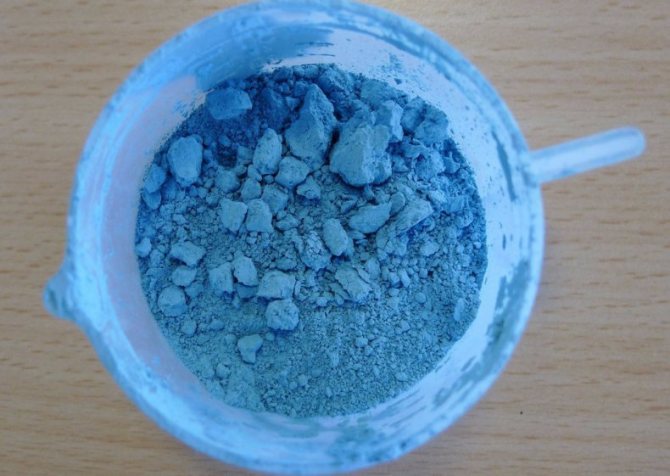

- It is allowed to use a solution or mixture based on copper sulphate only once within five years. More frequent use will destroy both the soil and the plant.
- It is recommended to process the plants before the events that are important for them: before the beginning of winter, when the leaves fall, or after the snow melts, but the buds have not yet opened.
- It is recommended to process in dry calm weather, and so that for the foreseeable five to six hours there is practically no precipitation.
- It is allowed to process only tree trunks, bushes, as well as soil. Under no circumstances should you process flowers, as well as fruits, otherwise you can ruin the plant and get poisoned.
- It is allowed to spray the kidneys, but with a weak composition of copper sulfate: one hundred grams per ten liters of water.
- It is necessary to take precautions so that the solution does not get on the skin or the mucous membrane of the nose, throat, or eyes.
- The finished composition must be applied all within four to five hours. Then it becomes unsuitable for spraying.
How to apply in summer and autumn?
In the summer, you should not carry out the treatment with a solution of copper sulfate. At high air temperatures, above 30 degrees, spraying is also not recommended. This method of treatment is used only in emergency cases, when the seedlings show pronounced signs of magnesium deficiency:
- low growth rate;
- chlorosis;
- dying off of the upper shoots.
In the summer months, tomatoes are infected with gray and white rot, potatoes - with late blight, and cabbage - with a black leg. The presence of a disease can be determined by the following signs:
- in cabbage - the appearance of black rot;
- tomatoes have a small number of flowers and shoots.
It is in such situations that a solution of copper sulfate, having a concentration of 0.2%, is necessary to save the harvest.
It is necessary to carry out the processing procedure with a solution of copper sulfate no later than a month before the collection of the first ripe fruits.
In the autumn, treatment with copper sulfate is carried out after the trees have completely shed their leaves, while the air temperature remains above zero. These conditions must be observed in order to avoid the occurrence of chemical burns.
Processing trees and shrubs in autumn allows you to completely rid plants of insects and fungi. You should also spray the land on which the dropped leaves are located. Since it is there that many pests form a wintering place.
What is the difference between copper sulfate and iron sulfate? Fertilizer vitriol - photo
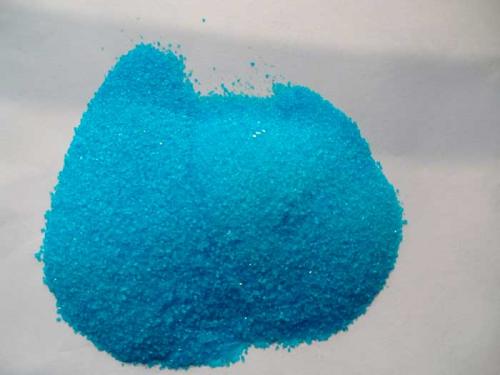

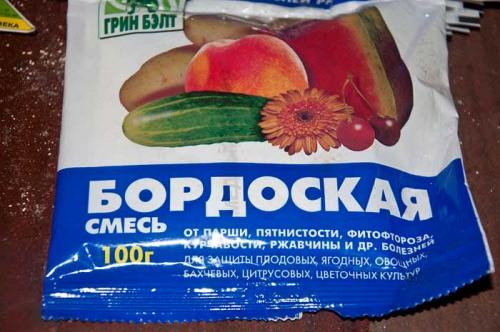

What is the difference between copper sulfate and iron sulfate?
- links do not go through, therefore, I am citing an article: There is a difference between these vitriol and a very big one. First, iron and copper, as chemical elements, have different effects on the vegetation process of plants. Secondly, the composition of trace elements in copper and iron sulfates is also not the same and they should be used competently and carefully.
For example, iron, without which many plants simply cannot exist. Iron currants and gooseberries are especially fond of. Berry growers also respond well to watering with rusty water from a barrel where metal waste with an iron content lies. And yet, plants cannot do without ferrous sulfate (iron sulfate). The fact is that bluish-green crystals of ferrous sulfate are practically the only available concentrated fertilizer containing 47-53% of the trace element iron. The lack of iron in plants contributes to the occurrence of various diseases, and especially such a dangerous one as chlorosis. In plants affected by chlorosis, growth stops, the edges of the leaves die off, sometimes there is premature leaf fall, the fruits become smaller, the yield is sharply reduced, and in some cases the tops and the whole tree dry out. Most often, the lack of iron is replenished by spraying the plants with a solution of ferrous sulfate. Foliar dressing can be done both during the growing season of plants with an aqueous solution of vitriol (50 g per 1 liter of water), and after the leaves have fallen (300 g per 10 liters of water). To combat chlorosis, a 1-1.5% solution of ferrous sulfate (100-150 g per 10 liters of water) is introduced into the soil. Iron vitriol is a well-known agent for the elimination of bad odors and disinfection of cesspools and places for keeping livestock and poultry.Copper sulfate (copper sulfate, copper sulfate) - blue crystals, contains 24% copper. Apples, pears and plums are the most sensitive to the lack of copper. Copper sulfate is used primarily for feeding plants on peat, sandy and other soils poor in mobile forms of copper.
Feeding with copper sulfate is carried out 3-4 times per season by spraying the plants with a working solution at the rate of 1 teaspoon (5 g per 10-15 liters of water). Autumn spraying of fruit and ornamental plants (after the leaves have fallen) or early-spring spraying before bud break is carried out with 3% working solution at the rate of 30 g per 1 liter of water. Copper sulfate is mainly used in a mixture with lime to spray fruit and berry, ornamental and berry bushes against scab, brown, white and perforated spots, coccomycosis and browning of cherry leaves, fruit and gray rot, black, root and common cancer of fruit plants, and others. diseases. Solutions of copper sulfate are also used to combat mosses and lichens on tree trunks.Treatment is carried out in the fall after leaf fall by spraying or coating the affected trees.
Chemical and physical characteristics
Copper sulfate is one of the most famous copper-mineral fertilizers used in horticulture and horticulture as a stimulant of immunity in plants and shrubs, an antiseptic and disinfectant, as well as a fungicide. Fungicides are chemicals that in high concentrations are most often toxic to humans and animals., which are used to prevent and treat fungal infections of the root and stem systems of plants. Damage by fungi (more precisely, by their spores) can cause a violation of the strength and other consumer properties of wood, a change in the color of the bark and stem, as well as their premature death (especially for fruit-bearing trees and shrubs).
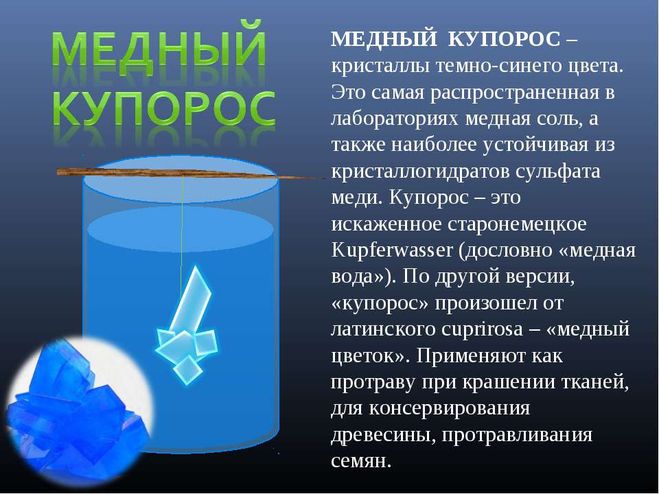

Copper sulfate
Properties
Copper sulfate (copper sulfate) has been used in horticulture for many decades and is considered one of the most powerful fungicides, although many modern drugs have appeared on the market to destroy the fungus. This is a light powder, which in nature is more often found in the composition of other mineral rocks, for example, cyanosite (chalcanthite). In industry, copper sulfate is obtained by blowing air by dissolving copper and its compounds in sulfuric acid.
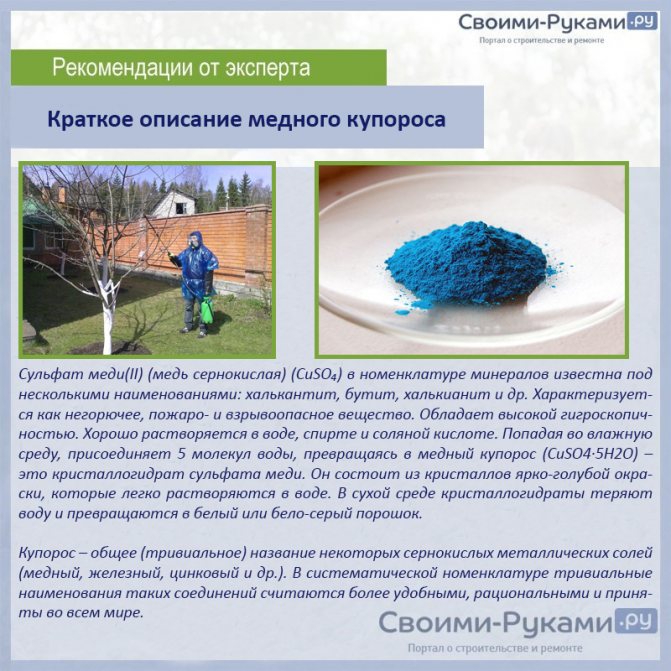

Brief description of copper sulfate
Copper sulfate pentahydrate, which is called copper sulfate, has a heavenly color and crystallizes from water-based solutions. The substance has the following properties, valuable for crop production:
- disinfects treated surfaces, which allows you to treat various lesions of the stem and root systems of plants and shrubs;
- eliminates copper deficiency, which is necessary for normal sap flow and fruiting;
- disinfects wood wounds;
- eliminates signs of floweringthat appear with an active accumulation of algae and phytoplankton (mainly in fresh stagnant waters);
- increases plant immunity.
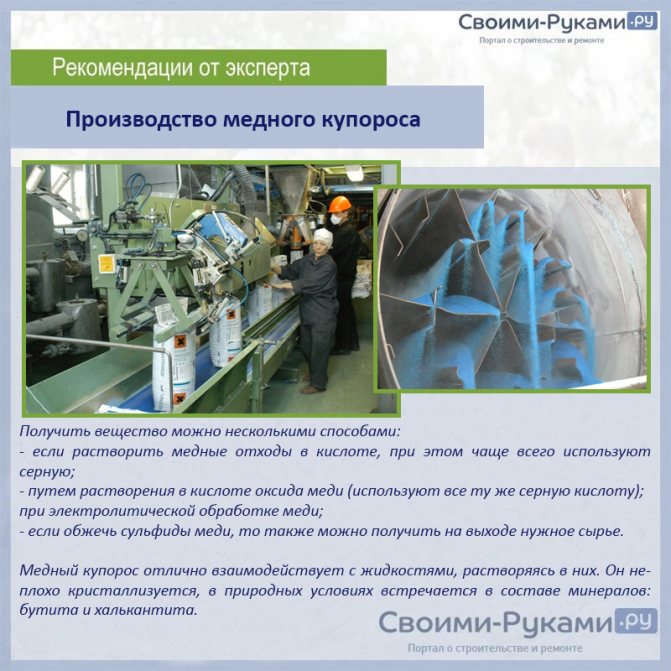

Copper sulfate production
Copper sulfate is also used in the production of some products as a color stabilizer and preservative (food additive E519). In some cases, the agent is indicated for providing emergency care for poisoning (provokes vomiting) and phosphorus burns.
Note! Copper sulfate, which is used in agriculture, is commercially available (with a corresponding mark on the packaging) and is intended for the preparation of an aqueous solution.
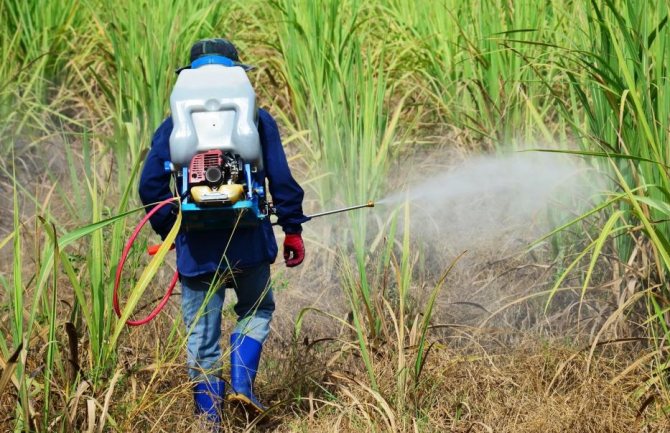

Copper sulfate in horticulture and plant growing
What is better copper or iron vitriol for grapes. Pros and cons of spraying
Let's start with the benefits, which are on the list. It is not for nothing that gardeners, when processing grapes, have resorted to vitriol from ancient times to the present day, despite the presence of more modern preparations on the market today. The main difference from them is the low price and availability. Iron or copper sulphate can be purchased at most hardware stores without serious loss to your budget.
As mentioned above, these substances are not too toxic compared to many other drugs and do not harm animal organisms. However, copper is inferior to iron in this regard, since it tends to accumulate in the soil. In general, both types of vitriol are quite environmentally friendly. If used correctly, there is no need to worry about unpleasant side effects.
These products boast good disinfecting properties, making them easy to cope with pathogens of various diseases. For example, a disease such as mildew is best prevented in advance. It will be much more difficult to cure it.
And also from the influence of copper and iron vitriol eggs and larvae of insects, mosses, fungi and lichens perish.
Under the influence of these substances, grape leaves more actively produce chlorophyll, enhancing their photosynthesis. This makes the stems more elastic, which helps to avoid damage. And when added to the soil, vitriol fills it with iron, which is necessary for the proper development of plants.
Now let's move on to the cons. Their list is noticeably shorter.
- First, iron and copper sulfates are not as good at treating diseases as at preventing them.
- Secondly, the effect of the substances lasts for about two weeks, which is why spraying must be done regularly.
- Thirdly, using vitriol, you must strictly follow the instructions.
Errors in application can lead to not the most pleasant, and maybe even fatal consequences:
- an increased concentration of these substances becomes toxic to living organisms, especially when it comes to copper sulfate;
- should not be used together with other drugs so that they do not enter into a chemical reaction;
- Plants may be burned due to improper spraying.
Iron vitriol for roses. How to process roses in autumn
Let's get acquainted with the basic rules for processing roses with iron vitriol in the fall.
Timing
Spraying the rose garden in the fall usually occurs after the plants have shed their foliage. Until this moment, the processing will be ineffective, will not allow achieving the set protective goals. However, if the foliage does not fall off for a long time, you can spray it on top of it: iron vitriol will contribute to falling off. But processing may not be 100% effective.
If for some reason the autumn spraying could not be carried out, postpone the procedure until spring. But in this case, it will be necessary to carry out the procedure before the buds on the bush begin to swell.
How to prepare and apply a solution
For ferrous sulfate to have the most effective effect on roses, the spray solution must be prepared immediately before using it. Storage of the drug is highly undesirable: it significantly reduces the effectiveness of the procedure.
The fact is that ferrous sulfate has a very fast oxidation rate. If the oxidation process is started, it cannot be stopped. The prepared solution, thus, quickly becomes useless, and even harmful to plants.
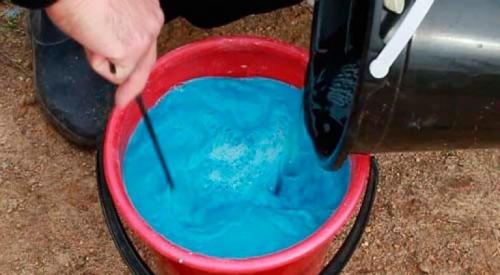

The most beneficial concentration of ferrous sulfate, which is guaranteed to relieve roses of most pests and other problems - 3%. Gardeners measure out 300 grams of dry matter and dissolve it in a standard ten-liter bucket of water. Note, however, that in spring such a concentrated solution cannot be used: it negatively affects young greenery. In the fall, you can and even need to.
If a shrub is sick with chlorosis or spotting, a 1% solution will help: but you need to use it until the foliage has flown around the plant. And the application must be repeated: at least three times, preferably four.
You can find out more about the features of the preparation of the solution and its application from
Advice
- Before spraying rose bushes in autumn, be sure to rake and remove fallen leaves from the site. We strongly recommend burning the leaves, as they may well contain harmful microorganisms, fungi and larvae.
- Carry out the procedure in dry, windless weather.
- Try to spray the solution so that it completely covers the entire plant. Gaps should not be allowed.
- After the roses are dry, you can start hiding them for the winter.
- You can not use iron vitriol in conjunction with other drugs for the fungus.
How to dilute the composition?
The preparation of a mixture with copper sulfate for the treatment of garden plants takes place in two stages:
- Preparation of mother liquor using copper sulfate. To prepare a mother liquor from copper sulfate, it is necessary to take a container that will not subsequently be used as a dish for food.Dissolve 100 g of copper sulfate in 1 liter of water. The water for preparing the mixture is used warm, about 50-60 degrees, for better dissolution of the powder. The mixture must be stirred to obtain a homogeneous composition. The resulting 10% solution is not suitable for use in horticulture. Before use, the masterbatch must be diluted with water to a copper sulfate concentration of 1 or 1.5%.
- Dilute the stock solution until the desired concentration is obtained. It is best to dilute the mother liquor in one container, into which, in addition to the mixture, water is added in the amount of 7-9 liters. It is recommended to treat garden plants with the resulting solution from a spray bottle or spray by hand.
Watch the video! How to dilute copper sulfate
Fungicidal treatment
Copper sulfate is one of the most powerful fungicides used in horticulture and horticulture for the treatment and prevention of fungal diseases, as well as seed dressing. As a fungicide, the drug is used, as a rule, in the Bordeaux liquid, which is a solution of copper sulfate in calcium hydroxide. Calcium hydroxide is also called milk of lime because it looks like milk and has the consistency of a suspension.
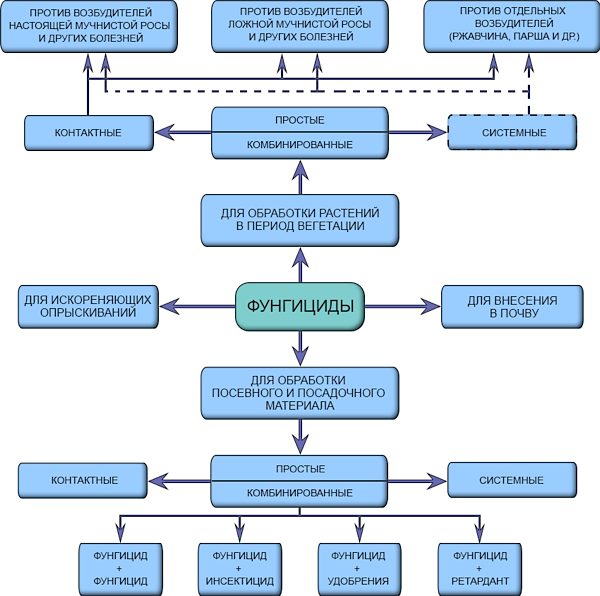

Fungicides
In addition to the therapeutic and prophylactic treatment of plants, milk of lime is also used in the food industry for the production of refined sugar. It can be applied to tree trunks as a fertilizing coating (trunks whitewashing) necessary for healthy growth and maturation of the bark and the formation of strong immunity.
Bordeaux liquid can be used for fungicidal treatment of any plants, but it is most in demand for the treatment and prevention of late blight in potatoes, as well as powdery mildew, chlorosis and powdery mildew in various grape varieties. You can prepare it according to two recipes.


Bordeaux liquid consumption rate
Recipe 1
- Dilute 100 g of quicklime calcium hydroxide in 150-200 ml of cold water (until the lumps are completely eliminated).
- Add another 5 liters of water to the resulting mass, stirring the solution constantly.
- Dissolve 100 g of copper sulfate in another container and also add 5 liters of water.
- Combine the resulting solutions and mix thoroughly.
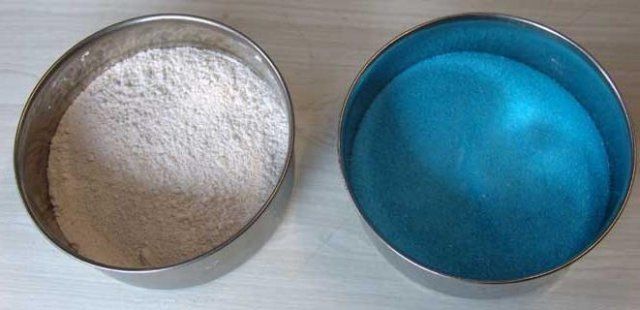

Calcium hydroxide and copper sulfate
The resulting working solution will have a concentration of 1%. The fact that the mixture is prepared correctly will be evidenced by the color of the finished solution: it should be light blue and have a turquoise hue.
Recipe 2
This recipe is used when it is necessary to process not individual shrubs, but the whole garden, that is, a large amount of working solution is required.
- Prepare two deep containers with a volume of at least 55 liters (metal containers will not work due to possible reactions).
- Pour 1 kg of copper sulfate into one container, and the same amount of calcium hydroxide into the other.
- Pour 500-600 ml of hot water with copper sulfate powder, stir until lumps are removed and add 50 liters of cold water.
- Add 50 liters of cold water to a container with quicklime, mix.
- Combine the solutions and stir thoroughly.
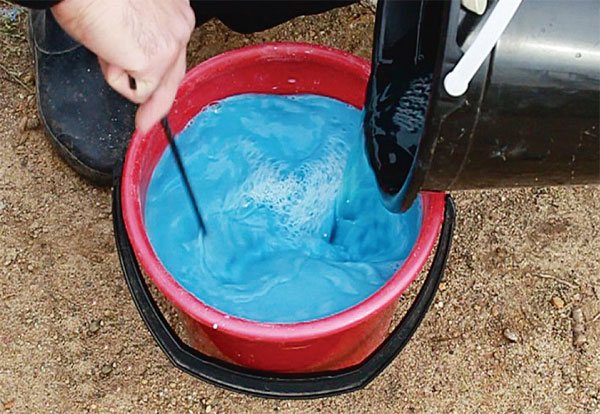

Stirring the resulting solution
The finished solution should have a beautiful color (the color of the sky). It is best to stir liquids with a wooden spatula.
Treatment stages
For the treatment and prevention of fungal diseases in plants, Bordeaux liquid is used by spraying or watering (under a bush). The treatment is carried out in several stages.
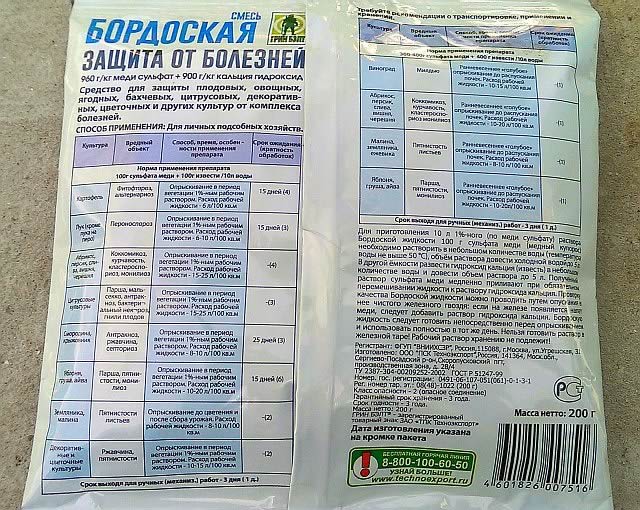

Bordeaux liquid, on the package - instructions for use
Table. Stages of treatment of fungal plant diseases using Bordeaux liquid.
| Stage | Number of fungicidal treatments | Possible crop losses due to improper or untimely processing at the appropriate stage |
| Primary treatment (the appearance of areas of necrosis with an area of less than 0.1% of the haulm) | 3 | More than 4% |
| The appearance of obvious signs of illness | 3 | More than 17% |
| Treatment after recurrent infestation (leaf damage over 3%) | 3 | More than 35% |
| Control | Without treatments (condition is assessed visually) | Total yield losses in the absence of the necessary treatment can range from 35% to 100% |
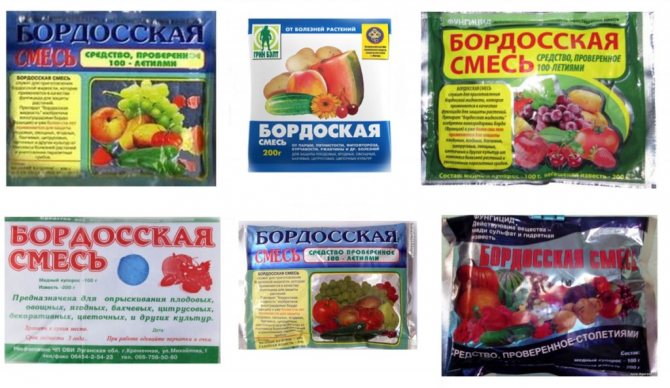

Ready-made bags with Bordeaux liquid
Gardeners' questions
What is copper sulfate for?
Copper sulfate is used for the prevention and treatment of diseases of horticultural crops caused by fungus or pathogenic microorganisms (mildew, powdery mildew, anthracnose and others). Copes well with some insect pests, including by destroying larvae.
In addition, copper sulfate is used as a foliar fertilizer. Most often on peat and sandy soils.
Has established itself as an excellent antiseptic against rot and mold.
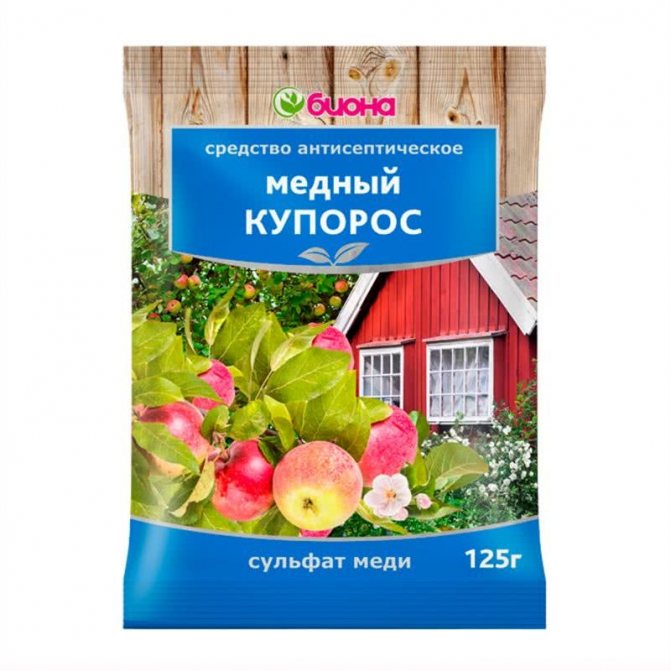

Can tomatoes be processed with copper sulfate?
Yes. Can.
How much copper sulfate is in teaspoons and tablespoons?
In 1 st. spoon - 16 g; in 1 tsp - 5 gr.
When can you process apple trees with copper sulfate?
Apple trees are cultivated in autumn, spring and summer.
Is copper sulfate harmful to humans?
The drug belongs to the 4th hazard class, that is, "low-hazard". Provided that the dosages and rules for working with it are observed, it really does not harm. However, if even a small amount of a substance gets inside the body, it can lead to acute poisoning. When working with the drug, it is imperative to use protective equipment.
Can cabbage be processed with copper sulfate?
Yes. Cabbage can be processed with copper sulfate. For example, at the seedling stage, when a disease is detected, spraying with a solution of copper sulfate is carried out. To prepare it, dissolve 1 tbsp in 10 liters of water. l. substances. If necessary, re-treatment is carried out after 21 days.
What is the color of copper sulfate?
Copper sulfate has a deep blue color.
Can roses be treated with copper sulfate?
Roses can be treated with copper sulfate in the presence of pests and diseases, as well as as a prophylaxis.
The principle of action of the substance
A solution of copper sulfate makes up for the lack of copper in the soil. Difficulties in growing vegetables and fruit crops arise for various reasons:
- poor ecological situation in the region;
- climate change (sharp warming, cooling);
- drought or high humidity;
- lack of black soil, marginal lands.
These problems lead to the loss of protective functions in plants, which means that the fruits become more susceptible to diseases, infection with fungal diseases or pests. Subject to safety measures, timely treatment with fungicides, fruiting trees, vegetable crops replenish the lost immunity.
The benefits of copper sulfate in the garden have been repeatedly proven on soil that does not contain black soil: peaty, sandy soil. There is always a shortage of copper in these types. Copper sulfate compensates for the deficiency in a short period of time.

